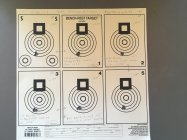You are using an out of date browser. It may not display this or other websites correctly.
You should upgrade or use an alternative browser.
You should upgrade or use an alternative browser.
Flat primers... sign of over pressure
- Thread starter garandman
- Start date
garandman
Bolt Gun Bodacious
@RegionRat
I need to learn more about neck sizing, generally. Like....why do it / why its better than FL sizing.
I need to learn more about neck sizing, generally. Like....why do it / why its better than FL sizing.
jepp2
Gold $$ Contributor
I need to learn more about neck sizing
Didnt really look have had this pet load for allmost a year and just fired away at reloading them didnt really care because they shot awesome and they wasnt hurting the rifle. Then i noticed my primer pockets stretching and seating force went down kept an eye on my brass because they were comming to the end of service and i noticed no more flat primers and just put 1&1 together and watched how hard i was seatin my primerAnd you didn't notice prior to firing?
Coyotefurharvester
Silver $$ Contributor
Not all primer brands are the same height, not all brands of brass have the same pocket depth. You need to be able to seat below case head without crush.
divingin
Gold $$ Contributor
- Case mouth split in fewer than 4 reloads (May mean high pressure or ammonia vapor exposure, but more often means case got too hot during annealing.)
[Note: My machine renumbered this for some reason - ignore the bullet point number]
Never heard of this with regards to annealing. Over annealing (assuming you can do this - AMP essentially says you can't) causes softer brass: I've seen people collapse shoulders, but never seen splits or cracks from over-annealing.
Case stretching excessively. (This is usually visible as pressure ring area stretching which may be due to excess pressure or to excess headspace. Use a bent paperclip or other probe to feel for thinning at the pressure ring. In rear bolt lug guns, the whole case may lengthen before resizing and be impossible to rechamber without sizing.)
[Hmmph. Quote tags don't seem to be working either. Not my day, I guess.]
I've never heard of the area just above the web of a case referred to as a pressure ring area, either. Stretching cases (and case head separation, which it inevitably becomes) can definitely be a problem; though I've never heard of it tied to pressure alone. I have heard it's tied to mid-to-high pressure and an excess of headspace that allows the case mouth to grip the chamber wall, and still allow the case base to migrate back to the breech face, stretching the brass at the weak point (just in front of the web.) Too much and the case integrity is compromised, leading to gas leakage into the chamber.
RegionRat
Gold $$ Contributor
The difference in discussion context is important.@RegionRat
I need to learn more about neck sizing, generally. Like....why do it / why its better than FL sizing.
There is a time and place where neck sizing is a tool in the tool box that you use when appropriate.
The problem pointed out by EC is to understand that it takes several cycles to get brass blown out.
An example is when you are into a strange new chamber and don't yet know how it will behave. This is a good time to take a very small sample of cases and cycle them with a medium load and cycle the brass till you have finished blowing it out or it causes problems. With close inspection, you learn things about the chamber and later on your dies.
ETA: It would be good to mention the alternatives when trying to study an unknown gun/chamber by learning to Cerrosafe cast the chamber and dies. Sometimes it is still worth taking a few cases through many cycles at the same time.
Last edited:
Jepp2's post was a great deep dive. I frequently see pressure signs on cartridges fired through AR10. There are pressure spike from using non-conforming cases (7.62x51 vs 308 Win,), thick and less malleable brass alloys used by foreign military ammo manufacturers, and finally hot loads that are safe in a bolt rifle but excessive pressure in a AR10. These are some cases (range brass) that I pulled out of my brass recycle bin... to clarify these are not my loads or rifle.
The two cases on the left have nice deep round dimples from the firing pin. Pressure has increased as you move to the right. There is a crater (raised lip) forming around the firing pin dimple, which is noticeably shallower and flatter, coupled with Ejector Swipes located at 3o'clock position. The crater lips are raised well above the face of the primer on both of these two cases. However, the primer has remained fully seated... as a result of military crimping/sealant.
It is possible to have a slight crater around the firing pin dimple that is result of the firing pin hole being too large for the firing pin creating a gap around the firing pin. The craters below are something different. There is enough pressure to flow the primer material back up into the firing pin hole in bolt face. The picture doesn't do it justice.. .the bottom of the dimples on right two cases are actually at or above the surface of the primer. If this were me shooting I would have immediately stopped shooting this ammo.
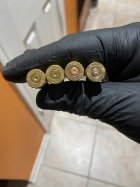
The two cases on the left have nice deep round dimples from the firing pin. Pressure has increased as you move to the right. There is a crater (raised lip) forming around the firing pin dimple, which is noticeably shallower and flatter, coupled with Ejector Swipes located at 3o'clock position. The crater lips are raised well above the face of the primer on both of these two cases. However, the primer has remained fully seated... as a result of military crimping/sealant.
It is possible to have a slight crater around the firing pin dimple that is result of the firing pin hole being too large for the firing pin creating a gap around the firing pin. The craters below are something different. There is enough pressure to flow the primer material back up into the firing pin hole in bolt face. The picture doesn't do it justice.. .the bottom of the dimples on right two cases are actually at or above the surface of the primer. If this were me shooting I would have immediately stopped shooting this ammo.

Last edited:
It does sound to me like a headspacing problem since it's apparent all across all your various loads. Too much clearance between the case head and bolt face allows the primer to back out during the initial charge ignition, then as the case swells to grab the chamber walls, the primer is pushed back in albeit with a flattened shape.@RegionRat
I need to learn more about neck sizing, generally. Like....why do it / why its better than FL sizing.
As for neck sizing, I do this for the first several cycles with new brass. When the brass starts to cause stiff bolt closure, this is an indication of a fully fireformed condition. Knowing this and recording the base to shoulder dimension gives you a reference point to set your FL sizing dies so that you only bump back the shoulder one or two thou. Then, as Speedy says, FL size every time to eliminate disruptive bolt closure issues when shooting competition, and to keep donut formation to a minimum.
That being said, my bolt gun 223 cases don't grow, so I only neck size them. This helps greatly with case life and eliminates neck trimming. I only occasionally need to anneal using this technique. Case volume on this smallish case is held more consistently, and accuracy is exceptional.
Yesterday, while out shooting I stumbled upon this exceptional example of excessive pressure...it shows every possible sign on the primer. At the 11 o'clock position there is an Ejector Swipe and at the 4 o'clock position there is the Extractor Mark (case rim heavily bent), the edges of the primer are definitely squared off, and the firing pin indention is reversed and now forming a Volcano standing high above the surface of the primer/base of case. For those interested this appears to be a 375 Raptor.
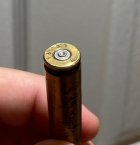
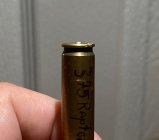


dellet
Gold $$ Contributor
Actually that looks a lot more like an extremely over gassed auto loader, than over pressure.Yesterday, while out shooting I stumbled upon this exceptional example of excessive pressure...it shows every possible sign on the primer. At the 11 o'clock position there is an Ejector Swipe and at the 4 o'clock position there is the Extractor Mark (case rim heavily bent), the edges of the primer are definitely squared off, and the firing pin indention is reversed and now forming a Volcano standing high above the surface of the primer/base of case. For those interested this appears to be a 375 Raptor.
View attachment 1276620View attachment 1276621
That was a very common problem with many magnum caliber AR style rifles when they were first being developed.
Yes, I believe that it was fired out of AR10. You have my attention - walk me through the excess gas as opposed to excess case pressure.Actually that looks a lot more like an extremely over gassed auto loader, than over pressure.
That was a very common problem with many magnum caliber AR style rifles when they were first being developed.
I thought the bent rim was indication of case sticking to chamber causing the extractor to torque the rim as it pried the case free from chamber as BCG was forced backwards during cycling.
Only the bent rim would indicate that as a possibility. The ejector mark (possible excessive headspace indication as well) and heavily cratered primer are a pretty clear sign of "high" pressure.Actually that looks a lot more like an extremely over gassed auto loader, than over pressure.
That was a very common problem with many magnum caliber AR style rifles when they were first being developed.
Primer flattening and cratering can indicate pressure relative to each other, a round with flatter primers or more cratering around the firing pin indicates that it is higher pressure than one with less. In my experience primer flattening is not an indication of overpressure even by definition. A flat primer has no impact on function or safety of a round.
Extrusions of the primer do though. So if you see the primer begin to flow into your bolt face to a degree that you may worry that it could pierce the primer or blow out of an edge of the primer then it becomes an issue.
Brass is always the tell for a high pressure indication though. If you get heavy bolt lift you need to back down. If your primer pockets become too loose after just a few firings you need to back down (or get tougher brass lol). If your brass extrudes itself into the bolt face you need to back down (or reduce headspace). Basically if it fires and extracts easily and doesn't damage your components you are good to go.
Last edited:
dellet
Gold $$ Contributor
Peak pressure vs Muzzle pressure, in relation to extraction timing.Yes, I believe that it was fired out of AR10. You have my attention - walk me through the excess gas as opposed to excess case pressure.
I thought the bent rim was indication of case sticking to chamber causing the extractor to torque the rim as it pried the case free from chamber as BCG was forced backwards during cycling.
In general high peak pressure results in lower muzzle pressure, Low peak pressure, results in higher muzzle pressure. It's what makes subsonic rounds cycle.
Peak pressure has very little to do with making the bolt in an AR unlock, it actually forces the locking lugs together, Gas to the carrier pushes the carrier back, and the bolt forward allowing it to unlock. If the pressure is equal on both sides of the bolt, the spring and buffer hold it closed and keep it from twisting to unlock.
If the system is over gassed, it's generally out of time, it's not pressure per say that is the problem, it's bolt speed. The bolt starts to unlock before the case walls recede from the chamber walls. The case sticks and the bolt rotates causing the swipe. The rim is bent from trying to extract the stuck case.
It's entirely possible and not uncommon to have excessive gas pressure at the muzzle, and not have an over pressure load. The pressure differential that allows the bolt to open should be timed to when the bullet exits the muzzle dropping the pressure holding the locking lugs.
There is a reason that Nemo Arms sells ammo for there rifles and tells you hand loads won't work. They had a lot of trouble with their shorter barreled 300 Winmags ripping the case heads off with factory ammo.
The reason that I think your example is more over gassed than over pressure is that I do not seem where the brass has an ejector mark where it flowed into the hole, or a "D" shaped impression from the extractor. If it was so over chamber pressure to cause an extraction problem, those to marks would be impossible to miss.
The reason that I think your example is more over gassed than over pressure is that I do not seem where the brass has an ejector mark where it flowed into the hole, or a "D" shaped impression from the extractor. If it was so over chamber pressure to cause an extraction problem, those to marks would be impossible to miss.
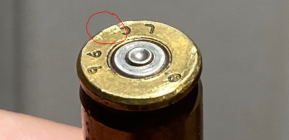
There is a half circle extractor mark right there. Not the best light but its there. Combined with the primer cratering I would say it was a hot round that also had poor timing. But timing problems itself can be a function of pressure. 70k psi will unlock a bolt earlier than 50k peak. An adjustable gas system or different weight buffer or strength spring can cure bent rim on almost any PSI round.
dellet
Gold $$ Contributor
If it wasn't for the bent rim, people would advise bushing the bolt face and continue. Since it's a floating pin, it probably looks worse than it actually is.View attachment 1276663
There is a half circle extractor mark right there. Not the best light but its there. Combined with the primer cratering I would say it was a hot round that also had poor timing. But timing problems itself can be a function of pressure. 70k psi will unlock a bolt earlier than 50k peak. An adjustable gas system or different weight buffer or strength spring can cure bent rim on almost any PSI round.
As for the area circled, I am not convinced that's an extractor mark. Even if it is, extractor marks on once fired military brass are common, so unless it showed up on other brass, I would file it in the watch for it again department.
It can be difference of opinion on priorities or what the tea leaves say, but if you're trying to diagnose pressure issues with primers and brass like what's pictured, you will never be able to guess chamber pressure issues until you get rid of the over gassed issue. If the gas had been turned completely off on that shot, the case would look completely different, and different opinions would be formed.
Knowing the load would generate another set of opinions.
In a gas gun I can put together proof pressure loads that will exceed 75,000 psi in the chamber with muzzle pressure so low, below 4000 psi, the bolt wont budge.
40,000 psi loads that will hyper cycle so fast the magazine can't feed the next round.
With a little work probably put together a 55,000 psi load that will look like the photo.
All I am saying is in my opinion, unless that was a 5% over book load, I would get the gas system working correctly, before even trying to guess if it was over chamber pressure.
Of course this is all based on the assumption, that round was extracted by firing. not with a hammer and rod. But if it stuck that hard, I don't think the primer would have held.
RegionRat
Gold $$ Contributor
It certainly is an interesting case.
I must also agree with @dellet in that the ejector imprint is pretty shallow compared to the bend in the rim and LC brass often tends to show a shallow ejector imprint before overpressure on the early cycles in an AR10. Sometimes you can get primer pattern indications from oversizing or headspacing issues.
That is not to say it should be ignored, but taken with everything else.
The best scenario is when the build recipe is well understood in terms of the gas, but often when a builder is doing uncommon calibers in the gas guns, they opt to open the port wide and use an adjustable block while they figure things out to avoid having to disassemble and open the port again.
Port pressure transducers are not common, so many times folks just experiment to find the right balance of load recipe and gun recipe. I relied on having strain gages at the chamber end as well as a port pressure transducer running together.
There is always a sliding scale on those issues with gas cycle and load pressure, so we could be seeing a mix of both or multiple issues with this particular case. It certainly shows why you have to be patient and prepared to roll up your sleeves and do some real work when you play with the higher energy in gas guns.
My own life sort of went in reverse. I learned on electric drive guns before they threw me at the gas guns, so I was familiar with the timing being simple at first, then much more complicated when gas operated. Gas operated guns have more pressure constraints to balance in order to keep things reliable.
I must also agree with @dellet in that the ejector imprint is pretty shallow compared to the bend in the rim and LC brass often tends to show a shallow ejector imprint before overpressure on the early cycles in an AR10. Sometimes you can get primer pattern indications from oversizing or headspacing issues.
That is not to say it should be ignored, but taken with everything else.
The best scenario is when the build recipe is well understood in terms of the gas, but often when a builder is doing uncommon calibers in the gas guns, they opt to open the port wide and use an adjustable block while they figure things out to avoid having to disassemble and open the port again.
Port pressure transducers are not common, so many times folks just experiment to find the right balance of load recipe and gun recipe. I relied on having strain gages at the chamber end as well as a port pressure transducer running together.
There is always a sliding scale on those issues with gas cycle and load pressure, so we could be seeing a mix of both or multiple issues with this particular case. It certainly shows why you have to be patient and prepared to roll up your sleeves and do some real work when you play with the higher energy in gas guns.
My own life sort of went in reverse. I learned on electric drive guns before they threw me at the gas guns, so I was familiar with the timing being simple at first, then much more complicated when gas operated. Gas operated guns have more pressure constraints to balance in order to keep things reliable.
Similar threads
- Replies
- 9
- Views
- 1,701
- Replies
- 31
- Views
- 1,830
Upgrades & Donations
This Forum's expenses are primarily paid by member contributions. You can upgrade your Forum membership in seconds. Gold and Silver members get unlimited FREE classifieds for one year. Gold members can upload custom avatars.

Click Upgrade Membership Button ABOVE to get Gold or Silver Status.
You can also donate any amount, large or small, with the button below. Include your Forum Name in the PayPal Notes field.
To DONATE by CHECK, or make a recurring donation, CLICK HERE to learn how.

Click Upgrade Membership Button ABOVE to get Gold or Silver Status.
You can also donate any amount, large or small, with the button below. Include your Forum Name in the PayPal Notes field.
To DONATE by CHECK, or make a recurring donation, CLICK HERE to learn how.










